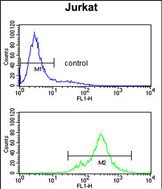SPRED1 Antibody
Affinity Purified Rabbit Polyclonal Antibody (Pab)
- SPECIFICATION
- CITATIONS
- PROTOCOLS
- BACKGROUND

Application
| FC, WB, E |
|---|---|
| Primary Accession | Q7Z699 |
| Reactivity | Human |
| Host | Rabbit |
| Clonality | Polyclonal |
| Isotype | Rabbit IgG |
| Calculated MW | 50477 Da |
| Gene ID | 161742 |
|---|---|
| Other Names | Sprouty-related, EVH1 domain-containing protein 1, Spred-1, hSpred1, SPRED1 |
| Target/Specificity | This SPRED1 antibody is generated from rabbits immunized with human SPRED1 recombinant protein. |
| Dilution | FC~~1:10~50 WB~~1:1000 E~~Use at an assay dependent concentration. |
| Format | Purified polyclonal antibody supplied in PBS with 0.09% (W/V) sodium azide. This antibody is purified through a protein A column, followed by peptide affinity purification. |
| Storage | Maintain refrigerated at 2-8°C for up to 2 weeks. For long term storage store at -20°C in small aliquots to prevent freeze-thaw cycles. |
| Precautions | SPRED1 Antibody is for research use only and not for use in diagnostic or therapeutic procedures. |
| Name | SPRED1 |
|---|---|
| Function | Tyrosine kinase substrate that inhibits growth-factor- mediated activation of MAP kinase (By similarity). Negatively regulates hematopoiesis of bone marrow (By similarity). Inhibits fibroblast growth factor (FGF)-induced retinal lens fiber differentiation, probably by inhibiting FGF-mediated phosphorylation of ERK1/2 (By similarity). Attenuates actin stress fiber formation via inhibition of TESK1-mediated phosphorylation of cofilin (PubMed:18216281). Inhibits TGFB-induced epithelial-to-mesenchymal transition in lens epithelial cells (By similarity). |
| Cellular Location | Cell membrane; Peripheral membrane protein. Membrane, caveola; Peripheral membrane protein. Nucleus Note=Localized in cholesterol-rich membrane raft/caveola fractions |
| Tissue Location | Weakly expressed in embryonic cell line HEK293. |

Thousands of laboratories across the world have published research that depended on the performance of antibodies from Abcepta to advance their research. Check out links to articles that cite our products in major peer-reviewed journals, organized by research category.
info@abcepta.com, and receive a free "I Love Antibodies" mug.
Provided below are standard protocols that you may find useful for product applications.
Background
SPRED1 is a tyrosine kinase substrate that inhibits growth-factor-mediated activation of MAP kinase.
References
Brems,H., Nat. Genet. 39 (9), 1120-1126 (2007)
Szafranski,K., Genome Biol. 8 (8), R154 (2007)
Yoshida,T., Oncogene 25 (45), 6056-6066 (2006)
King,J.A., Biochem. J. 388 (PT 2), 445-454 (2005)
If you have used an Abcepta product and would like to share how it has performed, please click on the "Submit Review" button and provide the requested information. Our staff will examine and post your review and contact you if needed.
If you have any additional inquiries please email technical services at tech@abcepta.com.













 Foundational characteristics of cancer include proliferation, angiogenesis, migration, evasion of apoptosis, and cellular immortality. Find key markers for these cellular processes and antibodies to detect them.
Foundational characteristics of cancer include proliferation, angiogenesis, migration, evasion of apoptosis, and cellular immortality. Find key markers for these cellular processes and antibodies to detect them. The SUMOplot™ Analysis Program predicts and scores sumoylation sites in your protein. SUMOylation is a post-translational modification involved in various cellular processes, such as nuclear-cytosolic transport, transcriptional regulation, apoptosis, protein stability, response to stress, and progression through the cell cycle.
The SUMOplot™ Analysis Program predicts and scores sumoylation sites in your protein. SUMOylation is a post-translational modification involved in various cellular processes, such as nuclear-cytosolic transport, transcriptional regulation, apoptosis, protein stability, response to stress, and progression through the cell cycle. The Autophagy Receptor Motif Plotter predicts and scores autophagy receptor binding sites in your protein. Identifying proteins connected to this pathway is critical to understanding the role of autophagy in physiological as well as pathological processes such as development, differentiation, neurodegenerative diseases, stress, infection, and cancer.
The Autophagy Receptor Motif Plotter predicts and scores autophagy receptor binding sites in your protein. Identifying proteins connected to this pathway is critical to understanding the role of autophagy in physiological as well as pathological processes such as development, differentiation, neurodegenerative diseases, stress, infection, and cancer.



